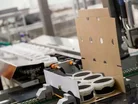Year in Review: Stora Enso

Stora Enso is among the world’s oldest companies with over 700 years of heritage, encompassing mining, iron and wood activities, stretching back to the 13th century. Today it focuses on all of the possibilities to manufacture a diverse range of products made from renewable materials with the forest and the trees as their foundation.
In an interview with Manufacturing Global magazine, Marko Yli-Pietilä, Stora Enso’s Head of Smart Operations, talks about meeting the challenges of accelerating a digitalisation programme encompassing operations, customer interface, supply chain, finance, HR and back office processes.
The digitisation of Stora Enso’s manufacturing fleet comprises around 100 production lines across many factories and is vital to achieve higher operational efficiency. “Operationally, we manufacture a diverse range of wood-based products. We’re also producing many completely new products, such as fiber-based composites,” says Yli-Pietilä.
“My role is focused on smart operations, which means the digitisation of production and maintenance needed to keep our factories running efficiently also in future.”
To discover more about how Stora Enso is investing in its digitisation programme and leveraging the benefits of new technologies such as artificial intelligence (AI), augmented reality (AR), machine learning (ML) and virtual reality (VR),the full feature can be found in the November issue of Manufacturing Globalor Stora Enso’s exclusive brochure.
SEE ALSO:
Stora Enso and Sulapac bringing sustainable straws to the market
Stora Enso’s 5G solution recognised at Industry of Things Awards
How will sustainable manufacturing be achieved in 2030?
Read the latest issue of Manufacturing Global here
Sustainability at Stora Enso
Stora Enso supports all seventeen of the United Nations Sustainable Development Goals (SDGs); the following three goals have been identified as the most strategic to the business:
SDG 12:
The use of renewable materials.
Involvement in the bioeconomy and circular economy.
Innovatingto improve resource and material efficiency.
SDG 13:
Renewable materials are an important part of the carbon cycle. They grow back and keep absorbing carbon dioxide and storing carbon.
Identify and analyse carbon risks and opportunities to establish their financial and non-financial impacts, the likelihood of their occurrence, and their root causes.
Stora Enso the first to set ambitious science-based targets for reducing its greenhouse gas emissions in 2017.
SDG 15:
100% of Stora Enso’s main raw material, wood, comes from sustainably managed forests that grow back.
Safeguarding forest biodiversity.
As wood is its most important raw material, Stora Enso’s key risks cover forest and land use.

